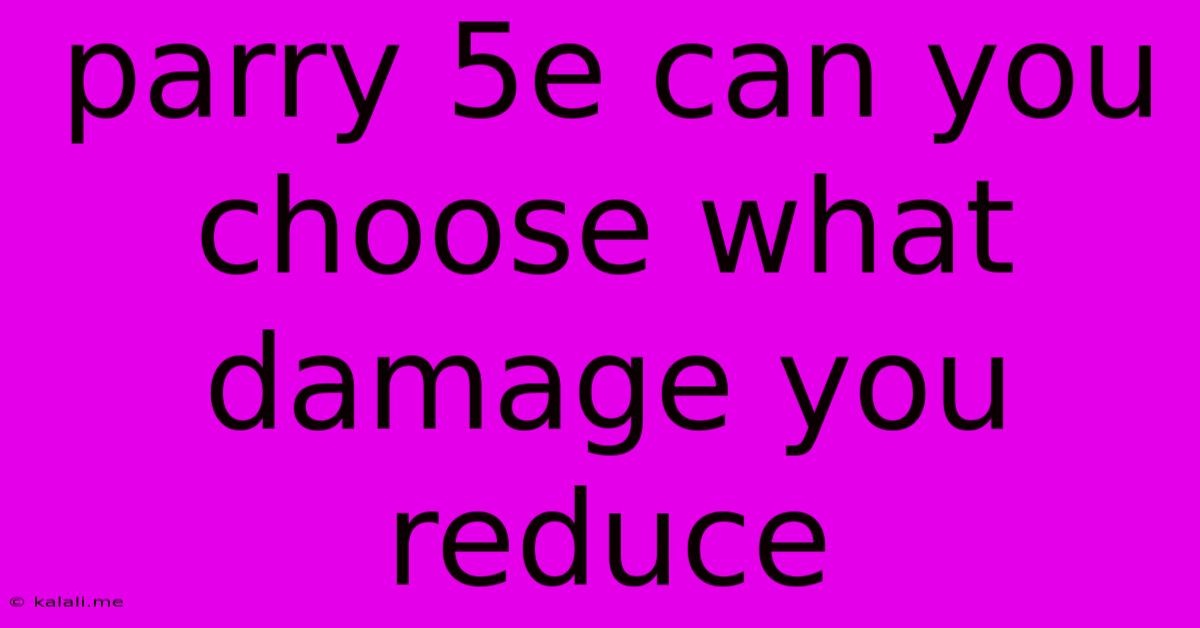Parry 5e Can You Choose What Damage You Reduce
Kalali
May 23, 2025 · 3 min read

Table of Contents
Parry 5e: Can You Choose What Damage You Reduce?
The Parry feat in Dungeons & Dragons 5th Edition (5e) is a popular choice for martial characters, offering a way to mitigate incoming damage. But a common question arises: can you choose which type of damage you reduce when using Parry? This article will delve into the mechanics of Parry, clarifying this ambiguity and providing strategic insights for maximizing its effectiveness.
Meta Description: Learn the mechanics of the Parry feat in D&D 5e. This guide clarifies whether you can choose which damage type to reduce with Parry and offers strategic advice for optimal use.
The short answer is no, you cannot choose which damage type Parry reduces. The feat's description clearly states that you reduce damage by 1d8 + your proficiency bonus. This damage reduction applies to the total damage taken from a single attack before any other damage reductions. It doesn't specify a particular damage type (like slashing, bludgeoning, or piercing). The reduction is applied to the final damage calculation after all other modifiers have been accounted for.
Understanding the Mechanics of Parry
The Parry feat grants you the following benefit:
While you are wearing armor, you can use a reaction when you are hit by a melee attack to reduce the damage by 1d8 + your proficiency bonus.
Let's break down the key components:
- Reaction: This means you can only use Parry once per turn, and only in response to being hit by a melee attack.
- Melee Attack: This clarifies that Parry only works against attacks made with melee weapons. Ranged attacks are unaffected.
- Armor: This requirement limits the usage of Parry to characters wearing armor. Unarmored characters cannot benefit from this feat.
- 1d8 + Proficiency Bonus: This is the fixed amount of damage reduction. The die roll adds an element of randomness, while your proficiency bonus scales the reduction with your character's level and expertise.
Strategic Considerations for Using Parry
While you cannot selectively reduce damage types, there are still strategic considerations for employing Parry:
- Prioritize Against High-Damage Attacks: Use your Parry reaction against attacks that deal significant damage. A small reduction against a minor attack might not be as valuable as a substantial reduction against a critical hit or a powerful enemy attack.
- Consider the Enemy's Attack Type: While you can't choose the damage type reduction, understanding the types of damage your enemies typically deal can inform your decision-making. If an enemy primarily deals bludgeoning damage, Parry still provides a beneficial reduction, even if it doesn't specifically target bludgeoning.
- Combine with Other Defensive Options: Parry works alongside other defensive abilities, such as shields and the Shield Master feat. Strategically combining these options can create a highly effective defensive posture.
- Situational Awareness: Evaluate the overall battlefield situation. Sometimes, sacrificing a small amount of damage to maintain your action economy for offense might be a better choice than using Parry.
Parry vs. Other Defensive Options
Parry is just one of many defensive options available in 5e. Comparing it to other feats and abilities helps illustrate its strengths and weaknesses. For instance, Shield Master offers more versatility but requires a shield, while other features like high Armor Class (AC) provide proactive defense. The best choice depends on your character build and playstyle.
In conclusion, although you cannot choose the damage type reduced by the Parry feat in D&D 5e, understanding its mechanics and employing strategic thinking can maximize its effectiveness in protecting your character. Remember to consider the overall situation before deciding whether or not to utilize your reaction for Parry.
Latest Posts
Latest Posts
-
Client Loop Send Disconnect Broken Pipe Ngrok Ssh
May 24, 2025
-
How To Find Eigenvectors From Eigenvalues
May 24, 2025
-
Can You Sub Oil For Butter
May 24, 2025
-
How Long Can Cooked Chicken Stay Out
May 24, 2025
-
How To Get Rid Of Rabbits In Yard
May 24, 2025
Related Post
Thank you for visiting our website which covers about Parry 5e Can You Choose What Damage You Reduce . We hope the information provided has been useful to you. Feel free to contact us if you have any questions or need further assistance. See you next time and don't miss to bookmark.